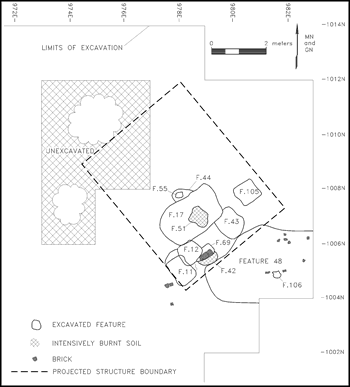Structure 1
 Structure 1 at Site 44JC969 is a rectangular building in the southern portion of the occupation area that measures about 15 x 20 feet, with no evidence of structural postholes or postmolds. Since the relationship of the subfloor pits to the chimney and the orientation of the structure based on the pit and chimney features is the same in Structures 1 and 2, the estimated size for Structure 1 was derived from Structure 2, where the structural postmolds allow an accurate determination of the size of the building.
Structure 1 at Site 44JC969 is a rectangular building in the southern portion of the occupation area that measures about 15 x 20 feet, with no evidence of structural postholes or postmolds. Since the relationship of the subfloor pits to the chimney and the orientation of the structure based on the pit and chimney features is the same in Structures 1 and 2, the estimated size for Structure 1 was derived from Structure 2, where the structural postmolds allow an accurate determination of the size of the building.
Structure 1 appears to have been of log construction, since log structures typically leave little or no subsurface evidence other than the location of the chimney and subfloor pit features. The predominance of pine wood charcoal recovered during the flotation of feature fill samples suggests pine log construction as a possibility. The economy and efficiency of log construction led to the dominance of this technique in the construction of slave houses by about the mid-eighteenth century, while earlier slave houses in the Chesapeake region were typically clapboard structures, built around posts driven directly into the ground at regular intervals. If this building represents a log structure, it may be that it was built later than Structure 2 and used for a shorter period of time. This idea is supported by the higher frequency of subfloor pits and the overlapping of some of these subfloor pits in Structure 2, and the comparatively small number of subfloor pits in Structure 1. Furthermore, later pearlware plate, bowl, teabowl, dish, and saucer fragments are strongly concentrated in the southern portion of the site in the vicinity of Structures 1 and 3, both of which appear to be later, log-constructed buildings.
The chimney was located off-center on the southwest gable end of the house. High densities of brick fragments and a short row of bricks in the hearth area indicate that at least part of the chimney was made of brick. The chimney appears to have been constructed in a manner similar to Structure 2, with chimney construction/support pits flanking either side of the hearth, no mortar, and very little daub recovered.
Subfloor pits were not common beneath Structure 1. One large subfloor pit was identified directly in front of the hearth, and another smaller subfloor pit was identified northeast of the hearth. The pit in front of the hearth is much larger and deeper than any other on the site. It appears to have been refilled, then reused as a pair of shallower subfloor pits, followed by a small informal hearth on top of the pit. A ledge was built-in along one side of the large pit. Exactly why the informal hearth was created is unclear; it may have been used after the structure was abandoned and the chimney was dismantled or no longer usable. The remains of the smaller, roughly square subfloor pit identified in the southeast corner of the structure are very shallow.
Pieces from a minimum of eight ceramic vessels were recovered from features associated with Structure 1. These vessels include two creamware plates, a pearlware plate and saucer, a coarse earthenware bowl and jar-like piece of hollowware made of cream-colored earthenware in the "pineapple" style, and a white saltglaze stoneware platter. One of the creamware plates is particularly important, because the fragments recovered date from 1790-1820 and were recovered from one of the two chimney construction/support features. This artifact suggests that, after the chimney brick was salvaged, the feature was filled sometime after 1790.
The presence of a very small amount of window glass suggests that the structure may have had glass windows; however, either the use of glass windows was very limited, or window glass was carefully salvaged when the structure was abandoned.
 Skip to main content
Skip to main content
